 |
| Figure 88. Gemini spacecraft No. 3 being unloaded at Cape Kennedy. (NASA Photo 104-KSC-65-00003, Jan. 4, 1965.) |
 |
| Figure 88. Gemini spacecraft No. 3 being unloaded at Cape Kennedy. (NASA Photo 104-KSC-65-00003, Jan. 4, 1965.) |
 |
| Figure 89. Simulated off-the-pad ejection test No. 13 at U.S. Naval Ordnance Test Station, China Lake, California. (NASA Photo No. 65-H-197, released Feb. 12, 1965.) |
| Figure 90. The tracking network for the second Gemini mission. (Air Force Photo ETR64-287-007/9820-276, Oct. 12, 1964.) |
 |
| Figure 91. Second stage of Gemini launch vehicle 5 being hoisted to the top of the vertical test facility at Martin-Baltimore. (NASA Photo S-65-2867, Feb. 8, 1965.) |
 |
| Figure 92. Location of command and communications system equipment on the Agena target vehicle. (Lockheed Photo NP-2-23, June 1, 1965.) |
 |
| Figure 93. Gemini-Titan 3 on pad 19 during final countdown exercises. (NASA Photo No. 65-H-406, released Mar. 19, 1965.) |
 |  |
|
Figure 94. Gemini spacecraft No. 4 entering the 14-foot altitude chamber at McDonnell before simulated high-altitude tests. (NASA Photo S-65-3420, Mar. 16, 1965.) |
Figure 95. Astronaut Edward H. White II practices standup extravehicular activity at a simulated altitude of 150,000 feet in the McDonnell altitude chamber. (NASA Photo S-65-4896, Mar. 24, 1965.) |
 |  |
|
Figure 96. Astronauts Young and Grissom walk up the ramp leading to the elevator that will carry them to the spacecraft for the first manned Gemini mission. They wear Gemini G3C intravehicular suits. (NASA Photo No. 65-H-438, released Mar. 23, 1965.) | Figure 97. Gemini spacecraft No. 3, wearing a flotation collar, being hoisted aboard the U.S.S. Intrepid after landing. (NASA Photo No. 65-H-462, released Mar. 23, 1965.) |
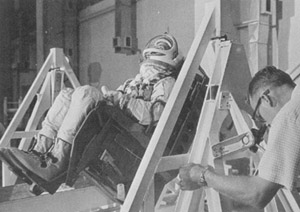 |
| Figure 98. Weight and balance test of Astronaut McDivitt during the Wet Mock Simulated Launch of Gemini-Titan 4. (NASA Photo No. 65-H-797, released May 21, 1965.) |
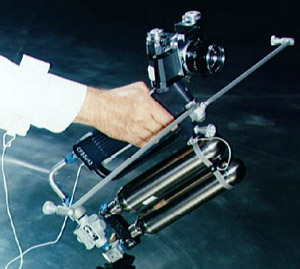 |
| Figure 99. The hand-held maneuvering unit. (NASA Photo S-65-27331, June 2, 1965.) |
 |
| Figure 100. Gemini spacecraft No. 5 undergoing clean-up prior to being shipped to Cape Kennedy. (NASA Photo S-65-5781, June 2, 1965.) |
 |
| Figure 101. Target Docking Adapter assembly. (McDonnell Report No. F169, Gemini Final Summary Report, Feb. 20, 1967, p. 548.) |
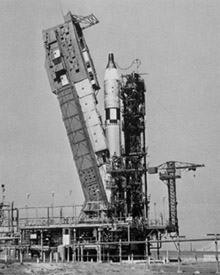 | 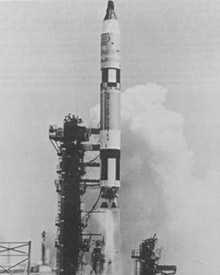 |
|
Figure 102A. Launch vehicle erector tower being lowered just prior to launch of Gemini-Titan 4. Difficulty in lowering the erector delayed the launch from the scheduled time of 9:00a.m. to 10:16a.m., e.s.t. (NASA Photo No. 65-H-934, released June 3, 1965.) | Figure 102B. Gemini-Titan liftoff. (NASA Photo No. 65-H-934, released June 3, 1965.) |
 |
| Figure 103. Astronaut Edward H. White II during extravehicular activity on the Gemini-Titan 4 mission. (NASA Photo No. 65-H-1019, released June 3, 1965.) |
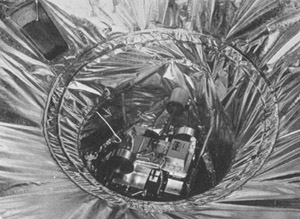 |
| Figure 104. Rendezvous evaluation pod installed in the equipment section of Gemini spacecraft No. 5 before launch vehicle mating. (NASA Photo S-65-41884, July 6, 1965.) |
 |
| Figure 105. Astronauts Charles Conrad, Jr., and L. Gordon Cooper, Jr., practice procedures for getting into their spacecraft in the Gemini 5 Wet Mock Simulated Launch. (NASA Photo S-65-41895, July 22, 1965.) |
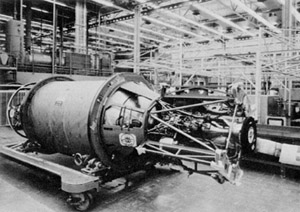 |
| Figure 106. Standard Agena D 108 being delivered to final assembly area. (NASA Photo S-65-8066, July 23, 1965.) |
 | 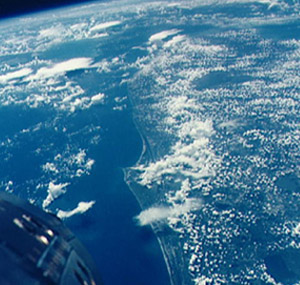 |
| Figure 107. Christopher C. Kraft, Jr., Robert R. Gilruth, and George M. Low in the Houston Mission Control Center when falling pressure in the oxygen supply tank of the fuel cell threatened the Gemini V mission. (NASA Photo S-65-28691, Aug. 22, 1965.) | Figure 108. Photograph of the Florida peninsula taken from the Gemini 5 spacecraft, looking south along the east coast, with Cape Kennedy in the foreground projecting into the Atlantic Ocean. (NASA Photo S-65-45388, Aug. 21-29, 1965.) |
 |
| Figure 109. Gemini spacecraft No. 7 in final shakedown in the cleanroom at McDonnell. (NASA Photo S-65-54127, Sept. 29, 1965.) |
 |
| Figure 110. Gemini spacecraft No. 8 in cleanroom at McDonnell for systems validation testing. (NASA Photo S-65-54125, Sept. 29, 1965.) |
| Figure 111. (A) General arrangement of sections in the augmented target docking adapter; (B)Augmented target docking adapter equipment installation. (McDonnell Report No. F169, Gemini Final Summary Report, Feb. 20, 1967, pp. 556, 544.) |
 |
| Figure 112. Mockup of the augmented target docking adapter at McDonnell, along with a spacecraft mockup. (NASA Photo S-65-62180, Dec. 12, 1965.) |
 |  |
|
Figure 113. Astronauts Frank Borman and James A. Lovell, Jr., walking up the ramp to the elevator at pad 19 prior to their Gemini VII flight. They are wearing the new lightweight G5C suits. (NASA Photo S-65-44290, Dec. 4, 1965.) |
Figure 114. Astronauts Borman (right) and Lovell on the deck of the U.S.S. Wasp after completing their 14-day mission. (NASA Photo No. 65-H-2323, released Dec. 18, 1965.) |
 |
| Figure 115. Gemini spacecraft No. 6 after removal from storage, being hoisted to the top of the launch pad at complex 19. (NASA Photo No. 65-H-1906, released Dec. 5, 1965.) |
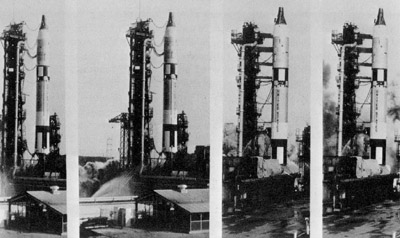 |
| Figure 116. Attempted launch and the shutdown of Gemini VI-A. (NASA Photo No. 65-H-1944, released Dec. 12, 1965.) |
 | 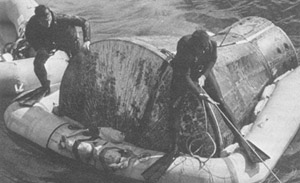 |
| Figure 117. The Mission Control Center at Houston just after the announcement from the orbiting spacecraft that Gemini VI-A and VII had achieved rendezvous. (NASA Photo No. S-65-62720, Dec. 15, 1965.) | Figure 118. U.S. Navy swimmers attaching the cable to the Gemini VI-A spacecraft, containing the astronauts, to haul it aboard the U.S.S. Wasp. The crew remained in the spacecraft during recovery. (NASA Photo No. 65-H-2294, released Dec. 16, 1965.) |


